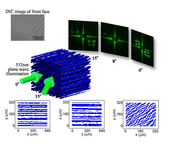Highlight
Volume optics: A new paradigm in photonics design
Achievement/Results
Researchers at the University of Colorado at Boulder, supported by the National Science Foundation (NSF), have shown a new type of aperiodic volume optical elements designed by a three-dimensional scattering approach.
Volume optics refers to a concept that aims at creating optical functionality within a three-dimensional (3D) system rather than from plane-to-plane as in traditional optical design. These devices are numerically-generated and present aperiodic 3D structures that control light in multiple dimensions including wavelength, time, and 3D space. This flexibility is significant because controlling light is the quintessential optical task. For example, volume optics could perform various laser beam shaping operations, multiplex different optical imaging functions, shape a laser pulse in space and time, or encode multispectral information.
During the last decade there has been a fantastic progress in the conceptual creation and implementation of micro-structured materials such as photonic crystals and metamaterials. With a few exceptions these designs are based either on periodic structures or disordered materials. In contrast, the Colorado researches are seeking aperiodic structures generated by design, with material variations spanning multiple scales.
The team shaped the refractive index of glass at the microscale according to a computer generated design following a set of mathematical constraints. Accordingly, they scanned tightly focused ultrashort laser pulses across the volume of a glass slab. They succeeded in demonstrating the concept with the design, fabrication, and characterization of volume optics that can multiplex arbitrary optical wavefronts in space and wavelength.
Address Goals
Volume optics could find applications in multidimensional pulse and beam shaping devices for quantum information and coherent control, in multiplexing specialized spatial filters for sensing and imaging, in anti-counterfeiting, or spectral imaging.
This seminal research was performed by graduate student Timothy Gerke and Prof. Rafael Piestun. The former is a fellow in the NSF funded, Integrative Graduate Education and Research Traineeship (IGERT) program in Computational Optical Sensing and Imaging. The research required integration of knowledge in optics, lasers, mathematics, materials processing, and signal processing, which are the foundation of the IGERT program at the University of Colorado.






